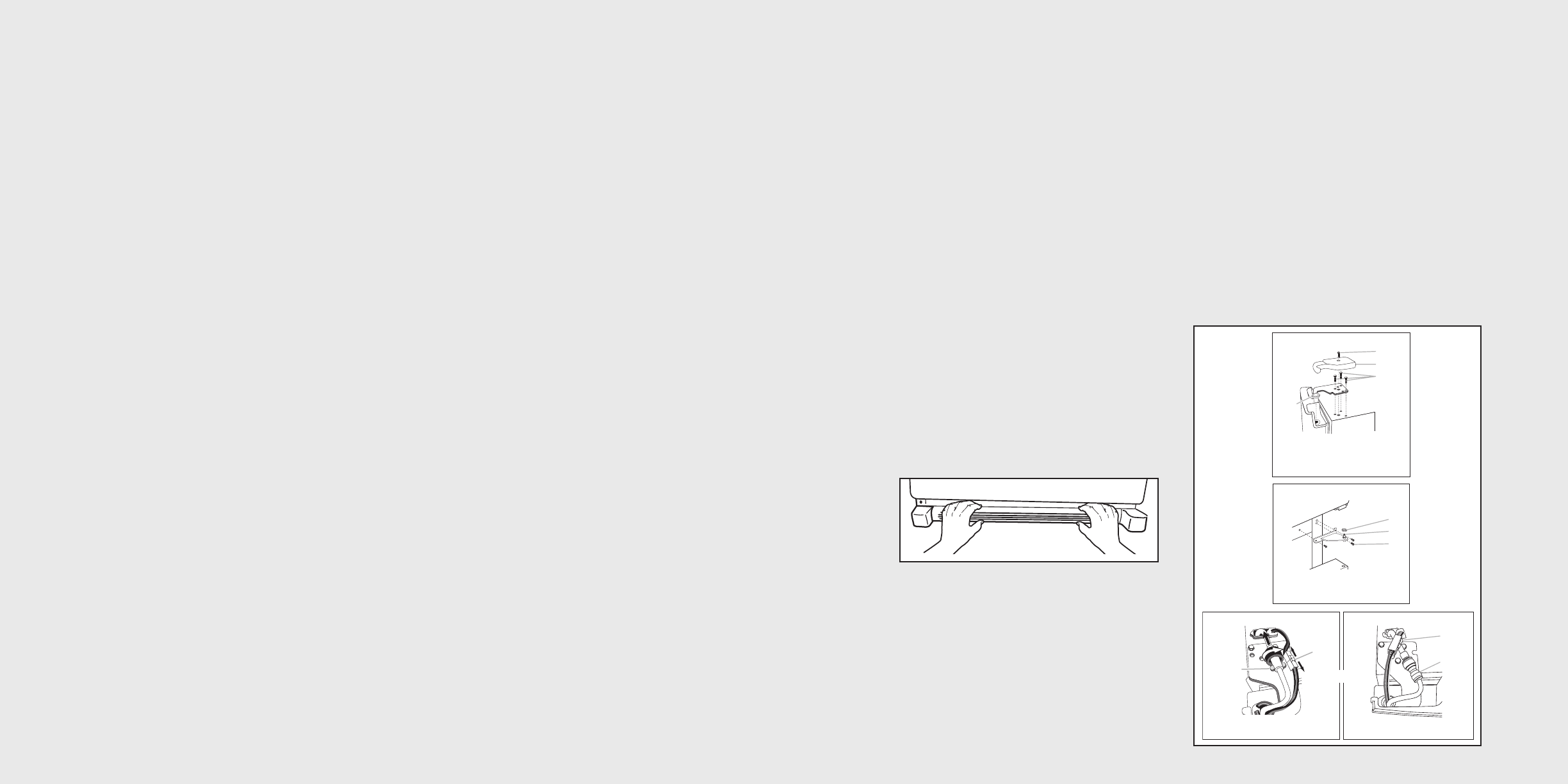
1514
Remove and Replace Handles
1. Using a 3/32"or 1/8” hex wrench, loosen the
two set screws located on the side of each
handle.
2. Pull the handle straight out from the door.
Make sure you keep the screws for reattaching
the handles.
3. To replace the handles, reverse the directions.
Remove Doors and Hinges
IMPORTANT:
• Remove food and any adjustable door or utility
bins from doors.
• Keep the refrigerator doors closed until you are
ready to lift them free from the cabinet.
NOTE: Provide additional support for the
refrigerator door while the hinges are being
removed. DO NOT depend on the door gasket
magnets to hold the door in place while you are
working.
TOOLS NEEDED: 5/16", 3/8", 1/4" hex-head
socket wrench, #2 Phillips screwdriver, and a flat-
blade screwdriver.
1. Unplug refrigerator or disconnect power.
2. Remove the base grille. Grasp the grille firmly
and pull it toward you.
3. Starting with the right-hand side door, remove
the parts for the top hinge as shown in Top
Hinge graphic. Lift the refrigerator door from
the bottom hinge pin.
4. Remove the shim from the bottom hinge pin
and keep it for later use. See Bottom Hinge
graphic.
5. Remove top hinge cover from left side
refrigerator door. Disconnect the wiring plug
located on top of the hinge by wedging a flat-
blade screwdriver or your fingernail between
the two sections. See Connections graphic.
.
Doors & Drawer Removal
Remove Doors and Hinges (cont.)
6. Disconnect the water line by holding the tabbed
section of the water line while turning the black
locking collar clockwise. See Connections graphic.
OR
6a.Disconnect the water line by pulling back on the
locking collar while pulling the water line out of
the water line connector. See Connections
graphic.
7. Remove the parts for the top hinge as shown in
Top Hinge graphic. Lift the left-hand side door
from the bottom hinge pin.
NOTE: On some models, remove the shim from
the bottom hinge pin and keep it for later use.
See Bottom Hinge graphic.
8. Using a 3/8" hex wrench, remove the leveling leg
brackets from the bottom of the cabinet. Keep
screws for later use.
General Information
Water Supply Requirements
A cold water supply with water pressure of
between 35 and 120 psi (241 and 827 kPa) is
required to operate the water dispenser and ice
maker. If you have questions about your water
pressure, call a licensed, qualified plumber.
Reverse Osmosis Water Supply
IMPORTANT: The pressure of the water supply
coming out of a reverse osmosis system going to
the water inlet valve of the refrigerator needs to
be between 35 and 120 psi (241 and 827 kPa).
If a reverse osmosis water filtration system is
connected to your cold water supply, the water
pressure to the reverse osmosis system needs to
be a minimum of 40 to 60 psi (276 to 414 kPa).
If the water pressure to the reverse osmosis
system is less than 40 to 60 psi (276 to 414 kPa):
• Check to see whether the sediment filter in the
reverse osmosis system is blocked. Replace the
filter if necessary.
• Allow the storage tank on the reverse osmosis
system to refill after heavy usage.
Reverse Osmosis Water Supply (cont.)
• If your refrigerator has a water filter, it may
further reduce the water pressure when used in
conjunction with a reverse osmosis system.
Remove the water filter.
If you have questions about your water pressure,
call a licensed, qualified plumber.
Top Hinges
A. Shim (on some models)
C. Hinge Screws
B. Bottom Hinge
Bottom Hinges
A
B
C
Connections
B. Wiring Plug
A. Tabs
A
B
A. Hinge Cover Screw
B. Top Hinge Cover
C.
5
/
16
" Hex-Head Hinge Screws
D. Top Hinge
B
A
C
D
Connections
A
B
A. Wiring Plug
B. Water Line Connection
6 6a
OR














